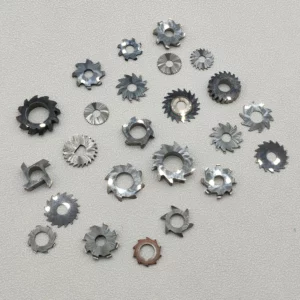Carbide cutting blades have revolutionized the field of machining with their exceptional performance in high-speed applications. These cutting-edge tools are widely recognized for their durability, precision, and efficiency. In this article, we will explore the key features that make carbide cutting blades the ideal choice for high-speed machining.
Table of Contents
ToggleSuperior Hardness and Wear Resistance:
Carbide cutting blades are made from a compound known as cemented carbide, which consists of tungsten carbide particles embedded in a cobalt matrix. This unique composition imparts exceptional hardness and wear resistance to the blades. As a result, they can withstand the high temperatures and abrasive forces generated during high-speed machining without losing their cutting edge.
Enhanced Cutting Speed and Efficiency
One of the primary advantages of carbide cutting blades is their ability to maintain sharpness at high cutting speeds. The hardness of carbide allows for faster machining rates, reducing production time and increasing efficiency. This makes carbide blades particularly well-suited for industries that require rapid material removal, such as aerospace, automotive, and manufacturing.
Improved Surface Finish
Carbide cutting blades excel in delivering superior surface finishes. The sharp cutting edges and precise geometry of these blades ensure clean and smooth cuts, minimizing the need for post-machining finishing operations. This not only saves time and effort but also enhances the overall quality of the machined components.
Extended Tool Life
Carbide cutting blades exhibit remarkable durability, resulting in extended tool life compared to traditional cutting tools. The wear-resistant properties of carbide allow the blades to maintain their sharpness for a longer duration, reducing the frequency of tool changes and downtime. This translates into cost savings and increased productivity for machining operations.
Versatility Across Materials
Carbide cutting blades offer excellent versatility in machining different materials. Whether it’s cutting through tough alloys, stainless steel, or non-ferrous metals, carbide blades can handle a wide range of materials with ease. This versatility makes them a preferred choice in various industries where multiple materials are involved.
Resistance to Thermal and Chemical Degradation
High-speed machining often generates intense heat and exposes the cutting tools to harsh chemicals. Carbide cutting blades are designed to withstand these challenging conditions. The combination of tungsten carbide and cobalt provides resistance to thermal deformation and chemical degradation, ensuring consistent performance even in demanding machining environments.
Precision and Accuracy
Accuracy is paramount in high-speed machining, and carbide cutting blades deliver exceptional precision. The rigidity and stability of carbide blades minimize deflection, resulting in precise cuts and dimensional accuracy. This makes them suitable for applications that require tight tolerances and intricate machining operations.
Carbide cutting blades have established themselves as the go-to choice for high-speed machining due to their exceptional hardness, wear resistance, and overall performance. Their ability to maintain sharpness at high cutting speeds, deliver superior surface finishes, and extend tool life makes them invaluable in various industries. With their versatility, precision, and durability, carbide cutting blades continue to drive advancements in high-speed machining, enabling manufacturers to achieve greater efficiency and productivity in their operations.
